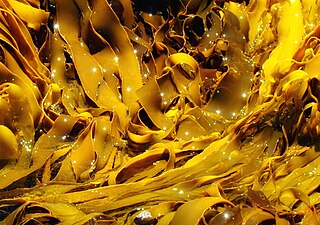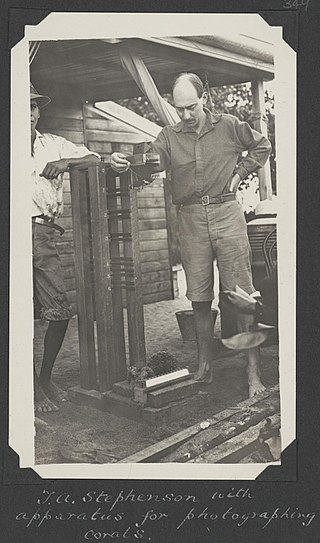Related Research Articles

Phycology is the scientific study of algae. Also known as algology, phycology is a branch of life science.
Elsie May Burrows was an English botanist who made significant contributions to British postwar phycology. Her primary area of research was macroalgal ecology, focusing particularly on Fucus, a genus of brown algae, and Chlorophyta, a division of the green algae.

Thomas Alan Stephenson FRS was a British naturalist, and marine biologist, specialising in sea anemones.
William Eifion Jones was a Welsh marine botanist, noted for his study of marine algae.
The history of phycology is the history of the scientific study of algae. Human interest in plants as food goes back into the origins of the species, and knowledge of algae can be traced back more than two thousand years. However, only in the last three hundred years has that knowledge evolved into a rapidly developing science.

Isabella Aiona Abbott was an educator, phycologist, and ethnobotanist from Hawaii. The first native Hawaiian woman to receive a PhD in science, she became a leading expert on Pacific marine algae.
The American-Australian Scientific Expedition to Arnhem Land remains one of the most significant, most ambitious and least understood expeditions. Commenced in February 1948, it was one of the largest scientific expeditions to have taken place in Australia and was conducted by a team of Australian and American researchers and support staff.

Thomas Bridson Cribb was a politician in Queensland, Australia. He was a Member of the Queensland Legislative Assembly and the Queensland Legislative Council.

Gavino Trono Jr. is a Filipino marine biologist dubbed as the "Father of Kappaphycus farming". He was conferred the rank of National Scientist of the Philippines for contributions to the study of tropical marine phycology, focusing on seaweed biodiversity. He is currently a professor emeritus of the University of the Philippines Marine Science Institute.
Máirin de Valéra MRIA was an Irish phycologist. She was the first chair and professor of Botany at University College Galway.
Elsie Conway was a British phycologist. She served as president of the British Phycological Society from 1965 to 1967, and was one of the earliest women Fellows of the Royal Society of Edinburgh.
Joan Winifred Cribb was an Australian botanist and mycologist.

James Ernest Walker was a lawyer and member of the Queensland Legislative Assembly.
Madura S. Balakrishnan (1917–1990) was born and raised in Madras, Madras Presidency, British India. He was a well-known botanist and he served various government positions and worked for some time at the University of Pune. He was the student of phycologist Professor M.O.P. Iyengar. The standard author abbreviation M.S.Balakr. is used to indicate this person as the author when citing a botanical name.

Robert Endean (1925–1997) was an Australian marine scientist and academic at the University of Queensland.

Wendy Alison Nelson is a New Zealand marine scientist and world expert in phycology. She is New Zealand's leading authority on seaweeds. Nelson is particularly interested in the biosystematics of seaweeds/macroalgae of New Zealand, with research on floristics, evolution and phylogeny, as well as ecology, and life history studies of marine algae. Recently she has worked on the systematics and biology of red algae including coralline algae, distribution and diversity of seaweeds in harbours and soft sediment habitats, and seaweeds of the Ross Sea and Balleny Islands.

Raymond Louis Specht was an Australian plant ecologist, conservationist and academic, who participated in the Arnhem Land Scientific Expedition of 1948.
William Randolph Taylor was an American botanist known as an expert in phycology.
Valerie May was an Australian phycologist, a pioneer and noted expert on toxic algae and water quality, and an interdisciplinary scientist who undertook algal ecology studies in Australia.
Margaret Constance Helen Blackler (1902–1981) was a British phycologist, botanical collector and museum curator.
References
- ↑ International Plant Names Index. Cribb.
- 1 2 3 4 5 "Alan Bridson Cribb" (PDF). Australian Marine Sciences Association Bulletin. 158: 13. April 2002.
- ↑ "Lakemba – Great Houses of Ipswich 2019". National Trust. Retrieved 7 September 2020.
- ↑ "PERSONAL". Queensland Times . 6 November 1950. p. 2. Retrieved 7 September 2020.
- ↑ "GREEN SPOTTED FISH SET EXPERTS POSER". The Courier-Mail . 8 October 1954. p. 13. Retrieved 7 September 2020.
- ↑ Specht, Raymond (2012). "American-Australian Scientific Expedition to Arnhem Land (1948): Its Long-Range Impact" (PDF). The Open Ecology Journal . 5: 53–83. doi: 10.2174/1874213001205010053 .
- ↑ "Untitled". Sunday Mail. 10 January 1954. p. 16. Retrieved 7 September 2020.
- 1 2 "Honours". Victorian Naturalist. 119 (1): 37–38. 2002.
- ↑ "Queensland Herbarium". www.cpbr.gov.au. 11 March 2020. Retrieved 7 September 2020.